Animal Parasiticides Market Size
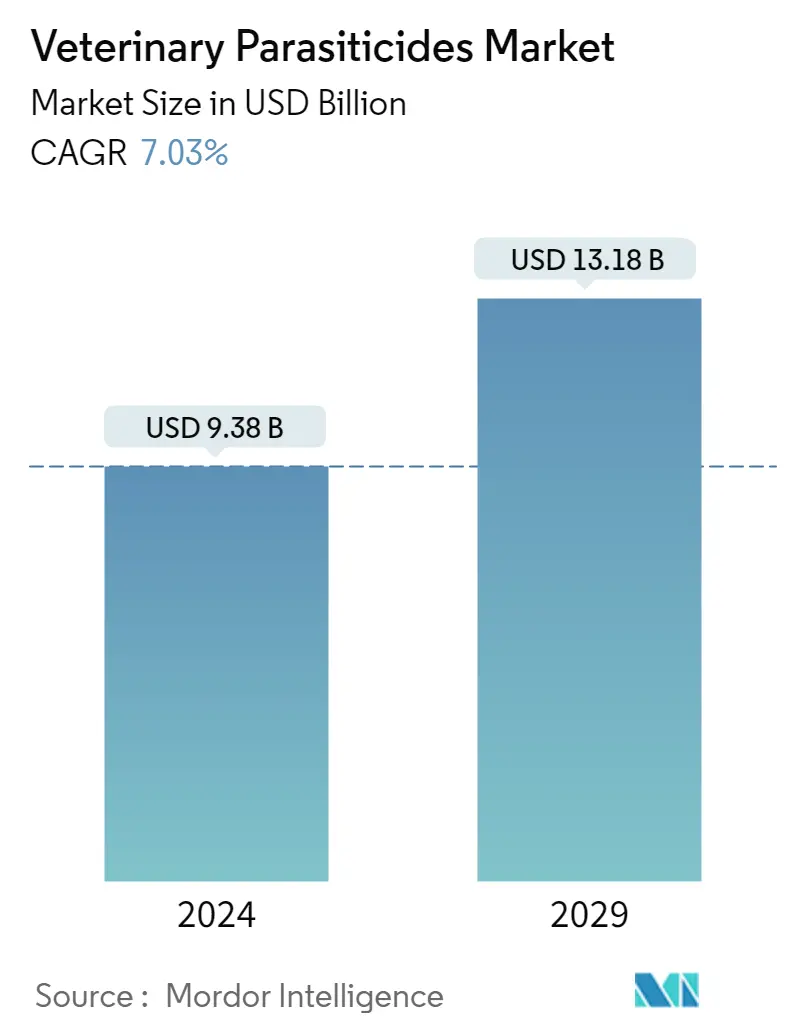
| Study Period | 2019 - 2029 |
| Market Size (2024) | USD 9.38 Billion |
| Market Size (2029) | USD 13.18 Billion |
| CAGR (2024 - 2029) | 7.03 % |
| Fastest Growing Market | Asia-Pacific |
| Largest Market | Europe |
Major Players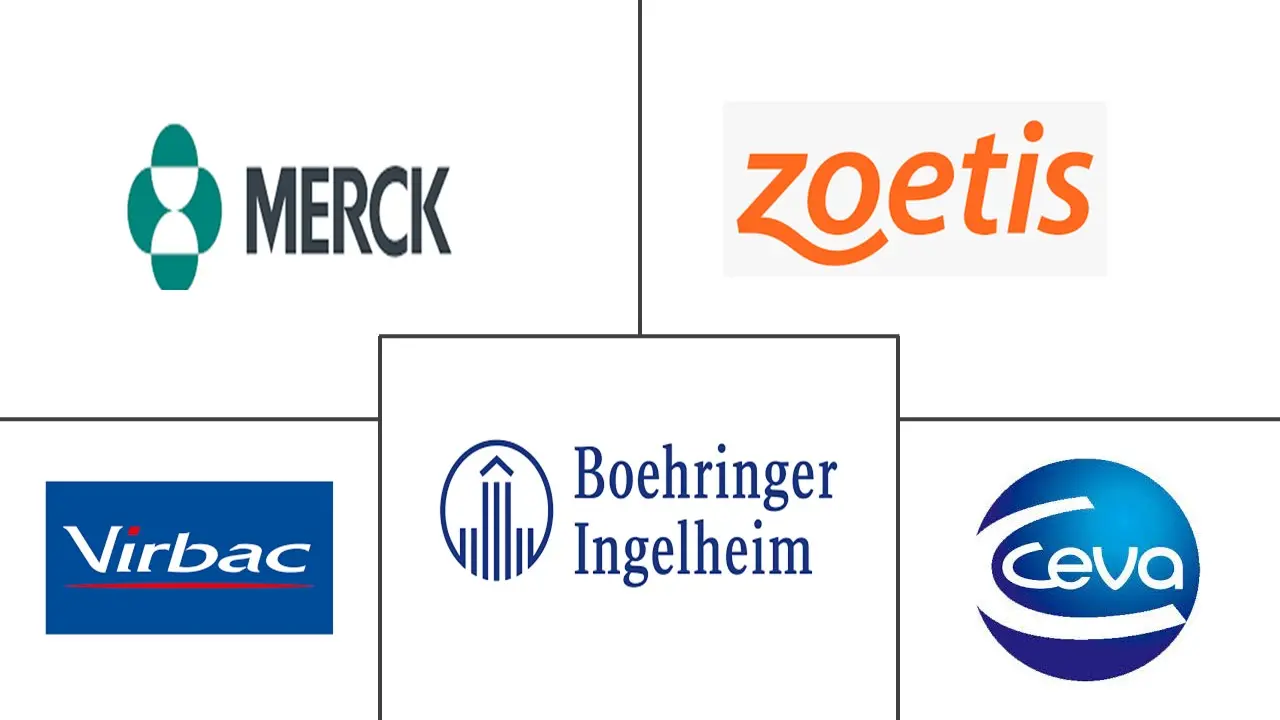
*Disclaimer: Major Players sorted in no particular order |
Animal Parasiticides Market Analysis
The Veterinary Parasiticides Market size is estimated at USD 9.38 billion in 2024, and is expected to reach USD 13.18 billion by 2029, growing at a CAGR of 7.03% during the forecast period (2024-2029).
The COVID-19 pandemic reduced the demand for animal care. Due to infection control measures and statewide lockdowns, the pandemic impacted the number of visits to veterinary hospitals and clinics. According to the study published in the Indian Journal of Animal Science in June 2022, there was a significant difference in the number of cases attended during different lockdown periods and among veterinarians, with a decline in the number of cases heard across pet species (54.9%), followed by goats (35.3%), sheep (29.1%), cattle (25.5%), and buffalo (21.6%) during the lockdown. During the lockdown, veterinarian visits fell by 27.3%, while farmer visits to veterinary clinics fell by 61.9%. As a result, the market is expected to be disrupted during the pandemic due to decreased veterinary holidays and a lack of veterinary pharmaceuticals during the pandemic. However, since restrictions were removed, the industry recovered quickly. In coming years, a rise in veterinarian visits and the reopening of veterinary clinics are expected to drive the market's growth.
The veterinary parasiticides market will show rapid growth due to the rising zoonotic disease prevalence and transmission from pets and farm animals to humans and rising animal healthcare expenditure. According to the study published in the Infection Ecology & Epidemiology in September 2021, one of the most dangerous zoonotic diseases in the world is salmonellosis. Salmonella prevalence in animals and risk factors for increased transmission of salmonella spp. from animals to people were evident. In Spain, the prevalence of salmonella in dogs accounted for 1.85%. In China, 243 dogs were found to have a slightly higher prevalence of salmonella at 9.47%. Thus, a higher risk of these diseases in dogs is expected to increase the demand for treatment over the forecast period.
Moreover, the growing adoption of pets worldwide is likely to propel the market's growth over the forecast period. For instance, according to the People's Dispensary for Sick Animals (PDSA) PAW Report 2022, there were 10.2 million pet dogs, 11.1 million pet cats, and 1 million pet rabbits in the United Kingdom in 2022. The same source reported 52% of UK adults would own a pet in 2022. This rising adoption of pets is expected to drive the market's growth over the forecast period.
Thus, all the abovementioned factors are expected to propel the market's growth. However, the stringent regulatory policies for the approval of animal parasiticides and the high cost of animal parasiticide products are hindering the development of the veterinary parasiticides market.
Animal Parasiticides Market Trends
This section covers the major market trends shaping the Veterinary Paraciticides Market according to our research experts:
Companion Animals is Expected to show High Growth During the Forecast Period
The companion animal segment is expected to develop at a high CAGR due to the increasing number of pet owners and their extra pet care decisions. According to National Pet Owners Survey 2021-2022 by the American Pet Products Association (APPA) in June 2021, 51% of pet owners are willing to pay more for ethically sourced and environmentally friendly pet items. Furthermore, 35% of pet owners reported spending more on pet supplies, wellness products, and other pet care items during the COVID-19 pandemic than in previous years. Such instances may positively impact the market's growth over the forecast period.
Additionally, the adoption of companion animals is rising globally as a result of the affection between humans and animals, which is widely acknowledged as an effective way to reduce stress during a period of uncertainty and assist in easing depression and anxiety due to social isolation, which is likely to propel the segment's growth over the forecast period. In March 2021, the Industrial Association of Pet Care Producers (IVH) and the German Pet Trade and Industry Association (ZZF) announced a survey result; as per the survey, almost 35 million dogs, cats, small mammals, and pet birds lived in German households in 2020. Overall, 47% of all German households owned at least one pet in 2020. The trend is further expected to grow during the forecast period.
Furthermore, new product launches by market players for companion animals play a significant role in market growth. For instance, in June 2021, Elanco Animal Health completed developing its comprehensive parasiticide portfolio with the recent marketing authorization of the new CredelioPlus in the United Kingdom for all-around parasite protection for dogs.
Thus, all the above factors are expected to boost the market's growth over the forecast period.
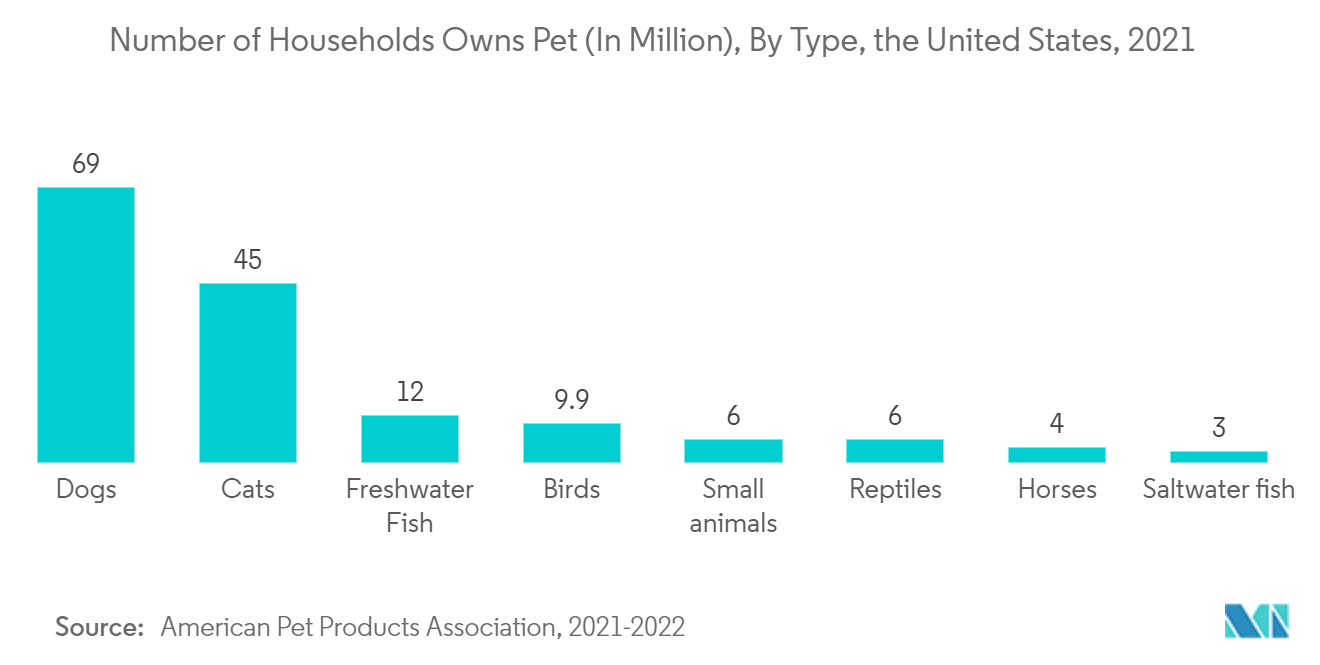
North America is Expected to Hold a Largest Share in the Market and Expected to do Same in the Forecast Period
North America currently dominates the veterinary parasiticides market and is anticipated to do so in the coming years. The United States is likely to maintain its substantial market share among the other nations, owing to expanding animal adoption and rising per capita animal healthcare expenditure. The rising trend of pet adoption in North America is also expected to drive the market's growth. For instance, according to the National Pet Owners Survey 2021-2022, conducted by the American Pet Products Association (APPA), around 70% of United States households have a pet, equating to 90.5 million houses, with 45.3 million cats and 69 million dogs. Furthermore, pet ownership recently increased in other nations in the region, including Canada and Mexico. According to Pet Keen, published in May 2022, a projected 38% of Canadian homes own a cat, and 35% own a dog. As a result, pet adoption and ownership in the region are projected to increase the prevalence of parasite infection as these animals are more susceptible to becoming infected with parasites. Furthermore, the source above indicated that pet owners in Canada are spending more money on their pets than ever before, with 17% prepared to spend more than USD 500 per year on pet healthcare. As a result, pets are more prone to become infected with parasites, and higher expenditure on animals may increase spending on parasite treatment, boosting the market's growth.
The major players are actively making strategic planning and new developments such as product launches, mergers, acquisitions, and partnerships to contribute to the market's growth. For instance, in June 2022, Zoetis Inc. reported the agreement to acquire Basepaws, a privately held petcare genetics company. The acquisition will advance Zoetis' portfolio in the precision animal health space and inform and shape its future pipeline of petcare innovations in dermatology and parasiticides. Therefore, the factors above are attributed to the market for veterinary parasiticides in North America and are anticipated to witness growth over the forecast period.
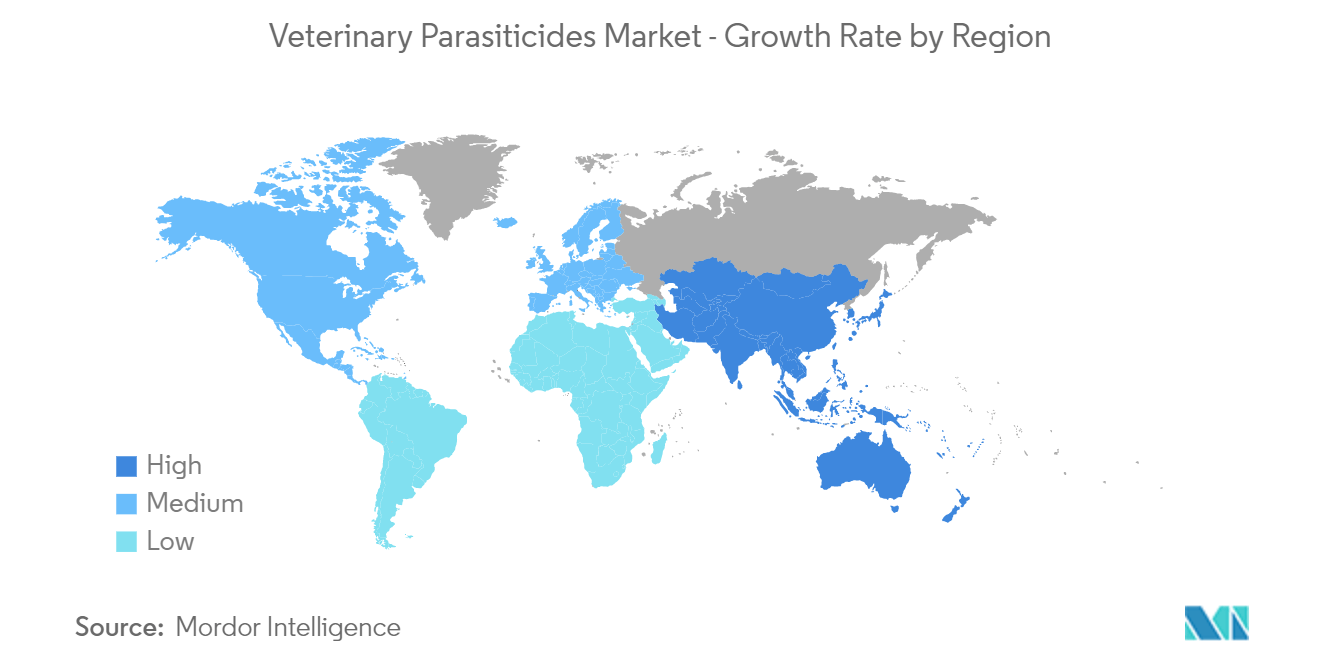
Animal Parasiticides Industry Overview
The veterinary parasiticides market is moderately competitive, with several players. Key players in the industry are focusing continuously on expanding their geographic presence using acquiring local market players. Acquisition of animal health assets of local payers by significant market players enabled major market players to increase their presence across various geographic regions and expand their veterinary health product portfolio. Some market players are Elanco Animal Health Incorporated, Boehringer Ingelheim International GmbH, Vetoquinol SA, and Zoetis Inc.
Animal Parasiticides Market Leaders
-
Boehringer Ingelheim
-
Virbac
-
Zoetis, Inc.
-
Ceva Sante Animale
-
Merck & Co. Inc.
*Disclaimer: Major Players sorted in no particular order
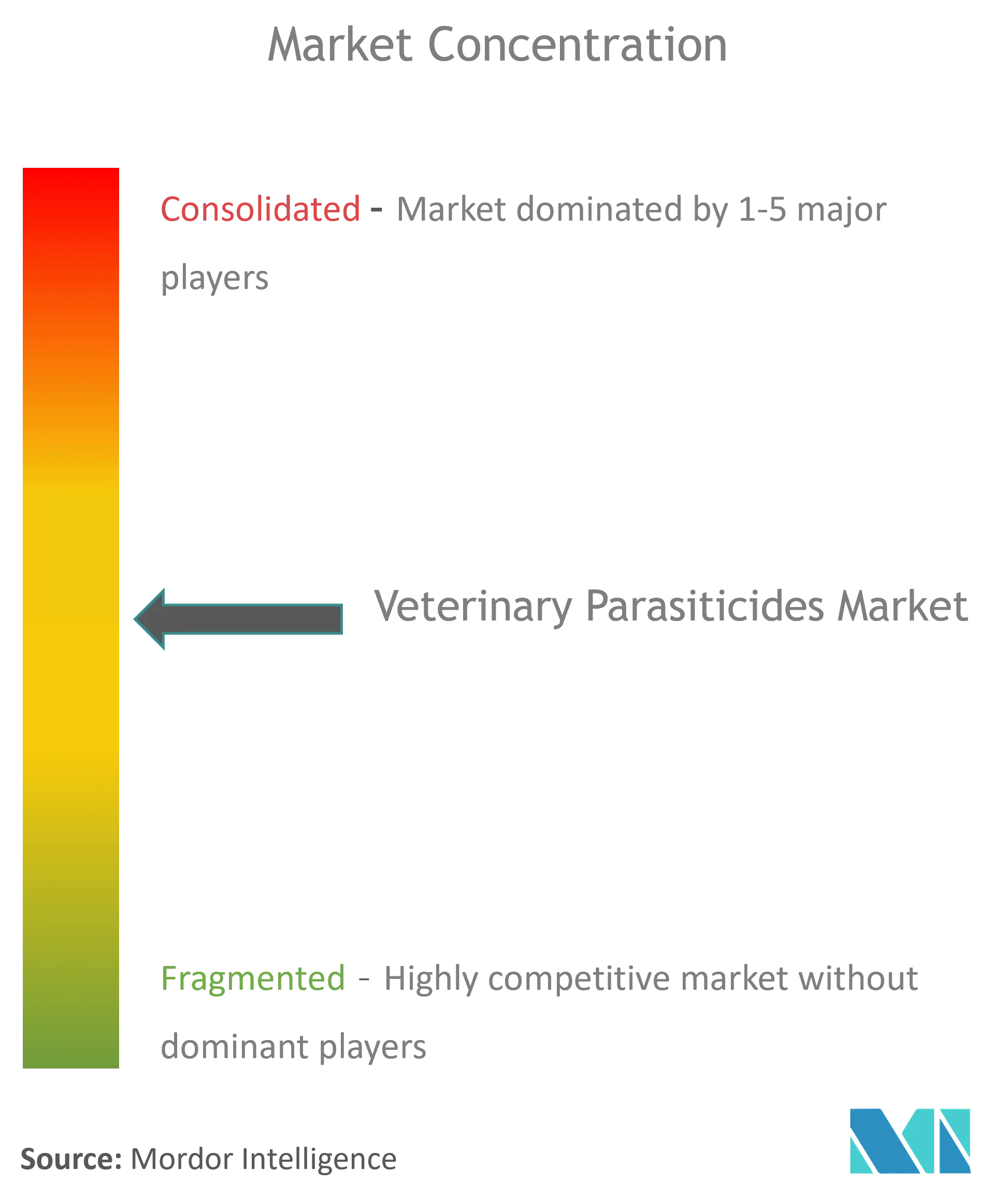
Animal Parasiticides Market News
- In September 2022, the British Veterinary Association (BVA), the British Small Animal Veterinary Association (BSAVA), and the British Veterinary Zoological Society (BVZS) collaborated to create a five-point plan to assist veterinary professionals in using parasiticide products responsibly in dogs and cats.
- In April 2022, Vetoquinol announced that Felpreva, a brand-new innovation in feline parasite protection, is now available for veterinarians to prescribe in the United Kingdom market. This statement comes after the Veterinary Medicines Directorate (VMD) awarded a marketing authorization in November 2021.
Animal Parasiticides Market Report - Table of Contents
1. INTRODUCTION
- 1.1 Study Assumptions and Market Definition
- 1.2 Scope of the Study
2. RESEARCH METHODOLOGY
3. EXECUTIVE SUMMARY
4. MARKET DYNAMICS
- 4.1 Market Overview
-
4.2 Market Drivers
- 4.2.1 Rising Prevalence of Food Borne and Zoonotic Diseases
- 4.2.2 Growing Adoption of Pet Animals
- 4.2.3 Rising Animal Health Expenditure
-
4.3 Market Restraints
- 4.3.1 Stringent Approval Process for Animal Parasiticides
- 4.3.2 High Cost of Animal Parasiticide Products
-
4.4 Porter's Five Forces Analysis
- 4.4.1 Threat of New Entrants
- 4.4.2 Bargaining Power of Buyers/Consumers
- 4.4.3 Bargaining Power of Suppliers
- 4.4.4 Threat of Substitute Products
- 4.4.5 Intensity of Competitive Rivalry
5. MARKET SEGMENTATION (Market Size by Value - USD million)
-
5.1 By Product Type
- 5.1.1 Ectoparasiticides
- 5.1.2 Endoparasiticides
- 5.1.3 Endectocides
-
5.2 By Animal Type
- 5.2.1 Food-producing Animals
- 5.2.2 Companion Animals
-
5.3 By Geography
- 5.3.1 North America
- 5.3.1.1 United States
- 5.3.1.2 Canada
- 5.3.1.3 Mexico
- 5.3.2 Europe
- 5.3.2.1 Germany
- 5.3.2.2 United Kingdom
- 5.3.2.3 France
- 5.3.2.4 Italy
- 5.3.2.5 Spain
- 5.3.2.6 Rest of Europe
- 5.3.3 Asia-Pacific
- 5.3.3.1 China
- 5.3.3.2 Japan
- 5.3.3.3 India
- 5.3.3.4 Australia
- 5.3.3.5 South Korea
- 5.3.3.6 Rest of Asia-Pacific
- 5.3.4 Middle East and Africa
- 5.3.4.1 GCC
- 5.3.4.2 South Africa
- 5.3.4.3 Rest of Middle East and Africa
- 5.3.5 South America
- 5.3.5.1 Brazil
- 5.3.5.2 Argentina
- 5.3.5.3 Rest of South America
6. COMPETITIVE LANDSCAPE
-
6.1 Company Profiles
- 6.1.1 Bayer AG
- 6.1.2 Boehringer Ingelheim
- 6.1.3 ELI Lilly and Company
- 6.1.4 Merck & Co. Inc.
- 6.1.5 Sanofi
- 6.1.6 Zoetis Inc.
- 6.1.7 Ceva Sante Animale
- 6.1.8 Virbac
- 6.1.9 Perrigo Company PLC
- 6.1.10 Soparfin SCA (Vetoquinol SA)
- *List Not Exhaustive
7. MARKET OPPORTUNITIES AND FUTURE TRENDS
** Subject To AvailablityAnimal Parasiticides Industry Segmentation
As per the scope of the report, animal parasiticides or antiparasitics are chemical substances used to eradicate parasites that infect pets and other animals and subsequently improve animal health. Most finished parasiticides contain one or more active ingredients that help carry out a specific action against particular parasites. The veterinary parasiticides market is segmented by product type (ectoparasiticides, endoparasiticides, endectocides), animal type (food-producing animals, companion animals), and geography (North America, Europe, Asia-Pacific, Middle East and Africa, and South America). The market report also covers the estimated sizes and trends for 17 countries across major regions globally. The report offers the value (USD million) for the above segments.
| By Product Type | Ectoparasiticides | |
| Endoparasiticides | ||
| Endectocides | ||
| By Animal Type | Food-producing Animals | |
| Companion Animals | ||
| By Geography | North America | United States |
| Canada | ||
| Mexico | ||
| By Geography | Europe | Germany |
| United Kingdom | ||
| France | ||
| Italy | ||
| Spain | ||
| Rest of Europe | ||
| By Geography | Asia-Pacific | China |
| Japan | ||
| India | ||
| Australia | ||
| South Korea | ||
| Rest of Asia-Pacific | ||
| By Geography | Middle East and Africa | GCC |
| South Africa | ||
| Rest of Middle East and Africa | ||
| By Geography | South America | Brazil |
| Argentina | ||
| Rest of South America |
Animal Parasiticides Market Research FAQs
How big is the Veterinary Parasiticides Market?
The Veterinary Parasiticides Market size is expected to reach USD 9.38 billion in 2024 and grow at a CAGR of 7.03% to reach USD 13.18 billion by 2029.
What is the current Veterinary Parasiticides Market size?
In 2024, the Veterinary Parasiticides Market size is expected to reach USD 9.38 billion.
Who are the key players in Veterinary Parasiticides Market?
Boehringer Ingelheim, Virbac, Zoetis, Inc., Ceva Sante Animale and Merck & Co. Inc. are the major companies operating in the Veterinary Parasiticides Market.
Which is the fastest growing region in Veterinary Parasiticides Market?
Asia-Pacific is estimated to grow at the highest CAGR over the forecast period (2024-2029).
Which region has the biggest share in Veterinary Parasiticides Market?
In 2024, the Europe accounts for the largest market share in Veterinary Parasiticides Market.
What years does this Veterinary Parasiticides Market cover, and what was the market size in 2023?
In 2023, the Veterinary Parasiticides Market size was estimated at USD 8.76 billion. The report covers the Veterinary Parasiticides Market historical market size for years: 2019, 2020, 2021, 2022 and 2023. The report also forecasts the Veterinary Parasiticides Market size for years: 2024, 2025, 2026, 2027, 2028 and 2029.
Animal Parasiticides Industry Report
Statistics for the 2024 Animal Parasiticides market share, size and revenue growth rate, created by Mordor Intelligence™ Industry Reports. Animal Parasiticides analysis includes a market forecast outlook to 2029 and historical overview. Get a sample of this industry analysis as a free report PDF download.



